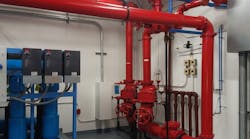The Secret to Saving Money on Fire Sprinkler Systems
Two winters ago, a parking garage owner reached out because their fire sprinklers froze and burst. It caused damage to the building, cars and the system. It cost them $40,000 to repair the fire protection. The next year, they spent $1,200 a week during the three-month winter season to have their fire sprinklers maintained professionally and had no issue.
By spending a little on proactive maintenance now, property owners save a lot.
Fire sprinkler inspection, testing and maintenance keeps systems in top working shape so if a fire were to occur, the system is ready to take action and halt it in its tracks. Fire sprinklers are effective over 80 percent of the time in containing a fire to its point of origin.
A system only fails when it is not kept in working condition does it fail.
Essentially, by maintaining fire sprinklers, building owners and facility managers are ensuring that their building is protected from extensive fire damage.
What Can’t Be Skipped?
An annual fire sprinkler inspection is the most vital inspection. Annual fire sprinkler inspections are the state minimum in Illinois and most other states.
Oftentimes, fire sprinkler heads are damaged and no one notices until the annual inspection. Sprinkler heads are painted over. A ladder accidentally hits a sprinkler. The damage is done, and no one will notice until an inspection or a fire occurs. A fire would be the worst way to find out a small accident made the sprinkler head unusable.
What Should You Focus On for Winter?
One maintenance item you should never skip in the winter is draining the drum drips in dry-pipe fire sprinklers.
Throughout the winter months, the news will have stories of properties flooding because a fire sprinkler pipe froze. It happens easily.
During a dry-pipe flush, small amounts of water can become trapped in the system based on the pitch of the pipe. The pitch of the pipe could change from the original installation due to the settling of the building. It will freeze and expand, causing tiny cracks. When the ice melts, the cracks will change the air pressure in the system. This trips a valve, and suddenly the pipe fills with water. The crack expands, and out of nowhere, a flood.
There is good news, though. This is easy to avoid.
Oftentimes, fire sprinkler heads are damaged and no one notices until the annual inspection. Sprinkler heads are painted over. A ladder accidentally hits a sprinkler. The damage is done, and no one will notice until an inspection or a fire occurs. A fire would be the worst way to find out a small accident made the sprinkler head unusable.
Facility managers only need to do three things to avoid a potential disaster.
1. Schedule inspections before it gets cold. The inspector can tell you if your pipe is at the correct pitch to avoid standing water. If it isn’t, re-pitch the pipe and install drum drips if they aren’t present already.
2. Drain drum drips weekly. This will remove any sitting water before it has the chance to freeze.
3. Complete trip tests. Every three years, test dry pipe sprinklers to make sure scaling, MIC or ice are not blocking the pipe. By doing these three simple tasks, facilities can avoid a frozen pipe disaster.
Future of Fire Protection Enforcement
The Chicago Fire Department recently increased the city’s fire protection inspection, testing and maintenance requirements. Fire pumps, standpipes and sprinklers must all be tested and inspected annually by an independent contractor who is a licensed Illinois Fire Sprinkler Contractor. This requirement was added to the Chicago Building Code in 2017 and will likely spread to building codes around the country.
By inspecting, testing and maintaining fire sprinklers on schedule, facilities save big money in the long run. Replacing or repairing a fire sprinkler system could cost anywhere from thousands to millions of dollars, depending on the size of the building.
But ongoing inspection, testing and maintenance is less expensive than most people think. For between $250-$1,000 per day, inspection, testing and maintenance can be completed on fire sprinkler systems, keeping them in optimal working order with no downtime. A price can be put on peace of mind, and it’s $250.
Gavin Hansen is the vice president of F.E. Moran Fire Protection. Gavin has been in the fire protection industry since he was 18 years old as a volunteer firefighter. Now, he is the vice president of F.E. Moran Fire Protection Northern Illinois, using his extensive fire protection knowledge to help facility and property managers in the Chicago area keep their buildings safe.
Two handpicked articles to read next:


